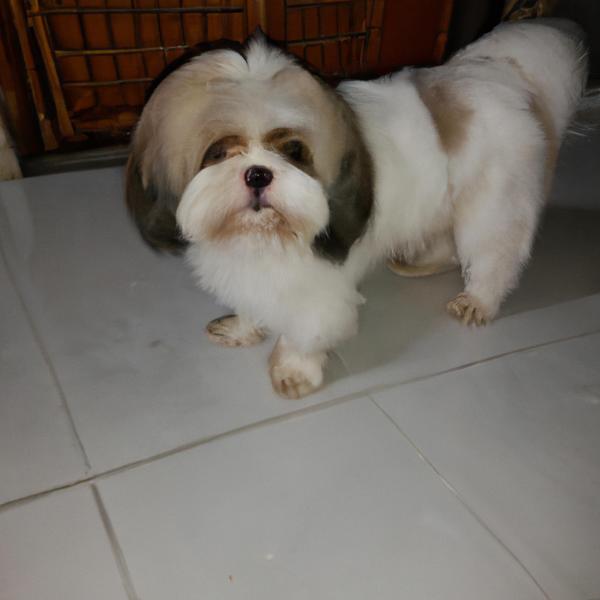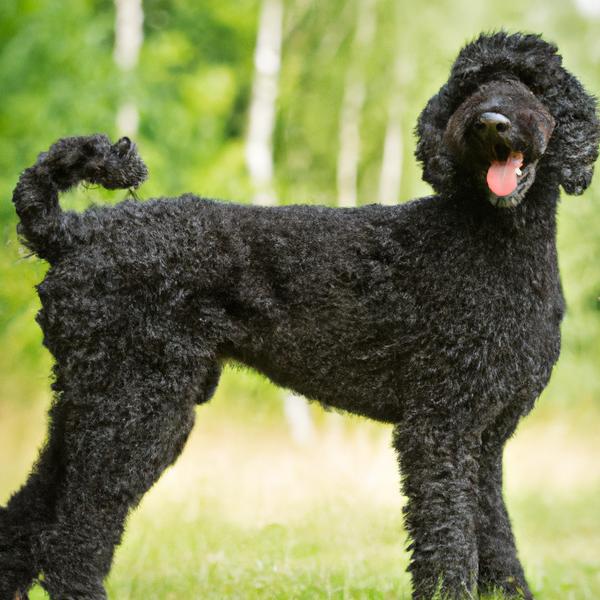Curly Coated Retriever vs. Silky Cocker: Breed Differences and Similarities
Hypoallergenic
Are Curly Coated Retrievers or Silky Cockers hypoallergenic, or neither?
Unfortunately, neither Curly Coated Retriever nor Silky Cocker are hypoallergenic, which may not make them the best choice for dog lovers who suffer from pet allergies.
Watchdog Ability
Which dog breed makes a better watchdog, the Curly Coated Retriever or Silky Cocker?
The Curly Coated Retriever and Silky Cocker breeds are not the best choice if you want good watchdogs. If you're looking for guard dogs, these breeds are not the right ones for you. They will 'watch' everything - but that's usually as far as they go.
Ancestry
What are the origins of Curly Coated Retriever and Silky Cocker breeds?
Spaniels, St. John’s Water Dog, Retrieving Setters, Poodles
Maltese and American Cocker Spaniel
Date of Birth
When were Curly Coated Retriever and Silky Cocker breeds first developed?
1700s
Unknown
Eye Color Possibilites
What are the eye colors of Curly Coated Retriever and Silky Cocker dogs?
Hazel
Brown
Brown
Nose Color Possibilites
What are the natural nose colors of Curly Coated Retriever and Silky Cocker?
Black
Brown
Black
Brown
Coat Color Possibilites
What are the natural colors of the coat for Curly Coated Retriever and Silky Cocker breeds?
Black
Brown
Black
Red
Cream
Brown
Coat Length
What is the typical coat length for Curly Coated Retriever and Silky Cocker breeds?
Curly Coated Retrievers have medium-length coats.
Silky Cockers have longer coats compared to most dogs.
Coat Density
What is the density of the coat of Curly Coated Retriever and Silky Cocker?
Coat Texture
What is the hair texture of Curly Coated Retriever and Silky Cocker?
Curly
Wavy
Litter Size
What is the usual litter size for Curly Coated Retriever and Silky Cocker?
A Curly Coated Retriever can have a litter of 9-14 puppies on average. However, it's worth noting that the size of the litters can vary greatly. Factors that can influence litter size include the health of the mother, breeding history, and genetics.
A Silky Cocker can have a litter of 6-8 puppies on average. However, it's worth noting that the size of the litters can vary greatly. Factors that can influence litter size include the health of the mother, breeding history, and genetics.
Major Concerns
What are the major health concerns for Curly Coated Retriever and Silky Cocker breeds?
Glycogen Storage Disease
Progressive Retinal Atrophy
Hip And Elbow Dysplasia
Bloat
Cancer
Cataracts
Retinal Dysplasia
Seborrhea
Skin Problems
Patent Ductus Arteriosus
Obesity
Minor Concerns
What minor health issues should be kept in mind when owning Curly Coated Retriever and Silky Cocker?
Entropion
Distichiasis
Ectropion
Persistent Pupillary Membrane
Alopecia
Entropion
Ectropion
Corneal Erosion
Phosphofructokinase Deficiency
Mono/Bilateral Cryptorchidism
Hydrocephalus
Skin Fold Dermatitis
Dental Disease
Portosystemic Shunt
Shaker Dog Syndrome
Occasional Tests
What occasional tests are recommended for Curly Coated Retriever and Silky Cocker breeds?
X-Rays
Eye Examination
X-Rays
Dental Examination
Physical Examination
Eye examination
Blood Tests
Energy
How do the energy levels of Curly Coated Retrievers and Silky Cockers compare?
Curly Coated Retrievers are a good choice for a low-key lifestyle due to their low energy levels.
Silky Cockers are suitable for those with a balanced lifestyle as they have an average energy level.
Exercise Needed
Curly Coated Retriever vs Silky Cocker exercise need comparison.
Curly Coated Retrievers need only a small amount of physical activity, ideal for busy or elderly people or those with limited space.
Silky Cockers need moderate physical activity and are great for families and active individuals.
Tendency to Bark
Do Curly Coated Retrievers or Silky Cockers bark more/less frequently?
Curly Coated Retriever and Silky Cockers tend to bark moderately, they bark when necessary, such as to alert their owner or to communicate something. They may also bark due to certain triggers like fear, alarm, boredom, greeting, separation anxiety and compulsive barking.
Activity Level
Which breed has higher energy, Curly Coated Retrievers or Silky Cockers?
Curly Coated Retrievers are high-energy dogs. They need mental as well as physical exercise. These dogs require a lot of your involvement and without it they can, and will, become problematic dogs.
Silky Cockers are medium-energy dogs and typically enjoy socializing and playing casual or even sustained games of chase with other dogs. They may also have occasional periods of barking or racing around the house.
Walks per Week
How many miles should Curly Coated Retriever or Silky Cocker walk each week?
There's really no limit to how far you walk your dog as long as they're comfortable. For Curly Coated Retriever, it's at least 14 miles / week. Just remember to build distance and stamina gradually over time.
There's really no limit to how far you walk your dog as long as they're comfortable. For Silky Cocker, it's at least 7 miles / week. Just remember to build distance and stamina gradually over time.
Activity per Day
Do Curly Coated Retrievers or Silky Cockers require more exercise?
In general most Curly Coated Retrievers usually need at least 90 minutes of exercise daily. This can be spread across the day and include all sorts of high-energy activities, like walking, running and playing.
In general most Silky Cockers usually need at least 60 minutes of exercise daily. This can be spread across the day and include all sorts of high-energy activities, like walking, running and playing.
Grooming
Which breed is easier to maintain in terms of grooming, Curly Coated Retrievers or Silky Cockers?
The Curly Coated Retriever has low grooming needs and is easy to maintain.
The Silky Cocker requires an average amount of grooming compared to other breeds.
Brushing Frequency
What is the recommended brushing frequency for Curly Coated Retriever and Silky Cocker dogs?
In general Curly Coated Retriever should be brushed at least once a month. Of course you can give them more frequent brushes, especially if they enjoyed it
Ideally, Silky Cocker should be brushed at least 2 or 3 times a week (preferably daily) improve shedding.
Brushing Tools
What brushing tools are used for Curly Coated Retrievers and Silky Cockers?
Slicker Brush
Comb
Deshedder
Nail Clipper
Slicker Brush
Comb
Deshedder
Nail Clipper
Cups
How much food should be given to Curly Coated Retriever or Silky Cocker in cups?
For an average 80-100 pound (36 - 45 kg) Curly Coated Retriever feed 3.5 cups daily. But, keep in mind, the amount you feed is going to be dependent on the quality of the food you are feeding.
For an average 14-18 pound (6 - 8 kg) Silky Cocker feed 1 cups daily. But, keep in mind, the amount you feed is going to be dependent on the quality of the food you are feeding.
Daily Cost
Which breed has a higher daily cost, Curly Coated Retriever or Silky Cocker?
The average cost of a Curly Coated Retriever is somewhere $3.90 - $4.20 per day.
The average cost of a Silky Cocker is somewhere $1.10 - $1.40 per day.
Monthly Cost
Which breed has a higher monthly cost, Curly Coated Retriever or Silky Cocker?
The average per month expenses of a Curly Coated Retriever is between $112 - $126. This makes an average of $1344 - $1512 per year. It will be on the higher side when the dog is still small because it will need more frequent visits to the vet, shots.
The average per month expenses of a Silky Cocker is between $35 - $42. This makes an average of $420 - $504 per year. It will be on the higher side when the dog is still small because it will need more frequent visits to the vet, shots.
Intelligence
Comparing Intelligence: Curly Coated Retrievers vs Silky Cockers
Curly Coated Retriever and Silky Cocker have average obedience intelligence, but they're also independent thinkers. This breed is known for having an exceptionally high IQ, which means they may get into trouble if left to their own devices.
Affection Dependance
Which is the more affectionate dog breed: Curly Coated Retriever vs Silky Cocker?
Dog Friendly
Which breed is more sociable with other dogs: Curly Coated Retriever or Silky Cocker?
Curly Coated Retrievers are not dog-friendly.
Silky Cockers are generally very friendly towards other dogs, with a happy and affectionate temperament.
Playfulness
Which breed is more playful between Curly Coated Retriever and Silky Cocker?
Curly Coated Retrievers are not known for being a highly playful breed.
Silky Cockers are a playful breed that needs daily playtime to be happy.
Trainability
How do the trainability levels of Curly Coated Retrievers and Silky Cockers compare?
The Curly Coated Retriever is highly intelligent and eager to please, making it a great choice for both novice and experienced dog owners due to its easy trainability.
Silky Cockers are popular for their ease of training and quick learning ability.
Compare Curly Coated Retriever with other breeds

Boston Huahua
Curly Coated Retriever vs Boston Huahua

Malchi
Curly Coated Retriever vs Malchi

Bullkita
Curly Coated Retriever vs Bullkita

Pug Shiba
Curly Coated Retriever vs Pug Shiba

Nekita
Curly Coated Retriever vs Nekita

Bulloxer
Curly Coated Retriever vs Bulloxer

Double Doodle
Curly Coated Retriever vs Double Doodle

Dashalier
Curly Coated Retriever vs Dashalier

Shiranian
Curly Coated Retriever vs Shiranian

Border Newfie
Curly Coated Retriever vs Border Newfie

Patterdale Shepherd
Curly Coated Retriever vs Patterdale Shepherd

Tibetan Pug
Curly Coated Retriever vs Tibetan Pug

